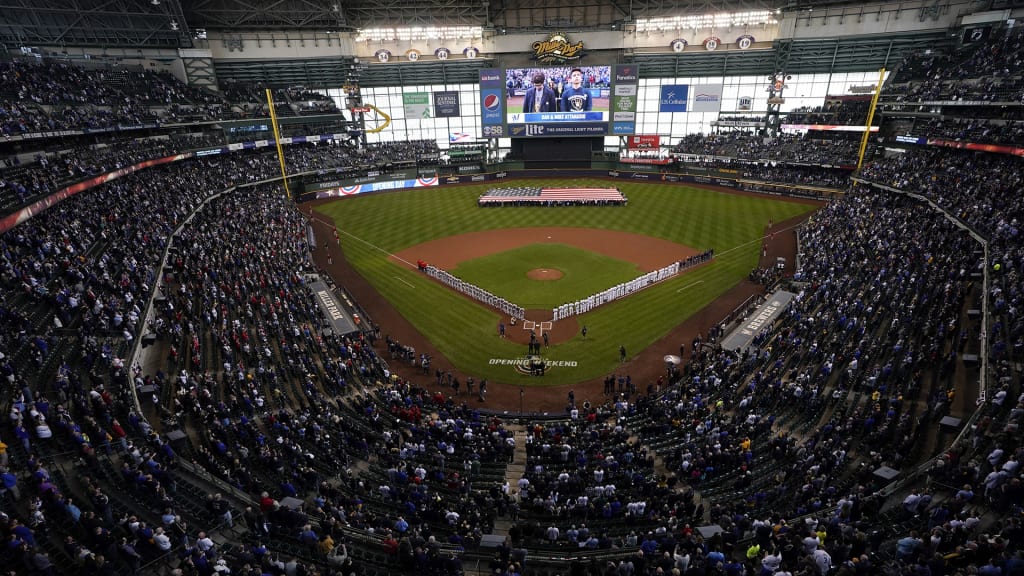
PHOENIX -- Miller Park has generated $2.5 billion in net economic output in its first 19 years of operation, according to a new study commissioned by the Milwaukee Metropolitan Association of Commerce -- benefits to the City of Milwaukee, Milwaukee County and the State of Wisconsin that would not have been realized without the existence of the Brewers and the ballpark.
The report from Conventions, Sports & Leisure International was released Monday to coincide with the upcoming start of the team’s 20th season in its retractable-domed home, and the sunset later this year of a 0.1-percent sales tax in the five counties surrounding the stadium.
“Twenty years later, with the Miller Park tax shortly to secede, the question we knew we were going to get. and that others would get was, ‘Has this been a valuable exercise? Has this been a good return on investment for putting a stake in the ground and building a new stadium for the team to play in?’” said Tim Sheehy, the longtime president of the MMAC. “The genesis of this report is really built around that.”
Sheehy suggested that the report says the answer to both questions is yes. He stressed that the findings represent economic activity that would not have occurred without the stadium.
Miller Park cost $392 million to construct from 1999-2001 and was largely publicly-funded, including via the implementation of the stadium tax. Since it opened, taxpayers have contributed about $600 million to the construction, maintenance and renovations of the ballpark, which is owned by the Southeast Wisconsin Professional Baseball Park District.
In that same time, the Brewers have invested about $107 million to maintain and enhance the stadium, according to the report. The Brewers have also paid $19.8 million in rent to the District since 2001.
“I think the person on the street would say Miller Park and the Brewers have been great for the community and an investment well-worth undertaking,” Brewers president of business operations Rick Schlesinger said. “It’s nice to see objective, statistical, factual analysis to sort of justify those intuitive views.”
CSL International notes in the report that it relied on financial information provided by the Brewers and other stakeholders that was not independently audited or verified.
Among the findings:
• The $2.5 billion in net total economic output refers to the total direct, indirect and “induced” spending effects generated by the Brewers and the ballpark that would otherwise not have been realized. The figures are higher in Milwaukee County ($3.3 billion in net total economic output) and the City of Milwaukee ($3.2 billion) because of the methodology of the study. For example, a fan visiting Miller Park from Eau Claire, Wis., would produce net new spending for Milwaukee County and the city, but not the state.
• Based on historical Brewers attendance data, approximately 22 percent of ballpark event
attendees are estimated to live within the City of Milwaukee, 38 percent within Milwaukee County and 86 percent within the State of Wisconsin.
• On an annual basis, the team and the ballpark generate approximately $16.8 million in net new tax revenue to the state, $1.8 million to Milwaukee County and $1.8 million to the City of Milwaukee. Over the last 19 years, the report estimates the total net new tax revenues as $262.9 million to the state, $25.2 million to the county and $24.3 million to the city.
• Miller Park has generated $1.2 billion in personal earnings to date, reflecting the wages and salaries of employees of businesses impacted by Miller Park operations over the past 19 years.
• The stadium generated the equivalent of 1,835 total annual jobs in 2019.
• The team and ballpark generated approximately $37.7 million worth of media exposure for the state of Wisconsin during a 12-month period from Oct. 1, 2018 to Sept. 30, 2019, which covered the Brewers’ appearance in the 2018 National League Division Series and NL Championship Series, as well as their surge to clinch the NL’s second Wild Card in 2019.
“There is going to be an ongoing discussion that we will never resolve about [how] economists view the economic impact of stadiums,” Sheehy said. “My point is we don’t live in a world of theory. There are limited number of these assets around the county, and if you want them, they need stadiums, especially in smaller markets.
“I would argue that the Brewers are more valuable than the Dodgers or the Yankees. And on its face, that may sound absurd, but I’m going to make that announcement on the basis that if Milwaukee didn’t have the Brewers, the name recognition, the visibility loss would hurt us far more than the Dodgers not being in L.A. or the Yankees not being in New York. As an organization, that has to go out every day and attract talent and companies, being a Major League city has a value that is hard to put an economic number on.”
The Brewers open the 2020 season at home against the Cubs on March 26.
“I think the people in this state should be proud,” Schlesinger said. “This ballpark is a jewel. It is a state-of-the-art facility. We -- the Brewers and the District -- invest a lot of treasure, time and attention to keep it state of the art.”
